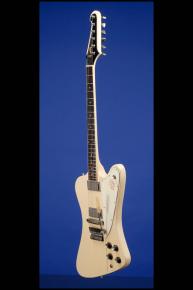A Near Mint Polaris White 1964 Reverse Firebird III…
This incredibly rare 'Polaris White' 'Reverse' Firebird lll guitar weighs just 8.40 lbs. and has a huge nut width of just under 1 3/4 inches and a standard Gibson scale length of 24 3/4 inches. Neck-through-body construction with two-piece mahogany center section and two glued-on wings. Mahogany neck with a medium profile and bound Brazilian rosewood fretboard with 22 original jumbo frets and inlaid pearl dot position markers. Headstock with gold-painted "Gibson" logo on black plastic truss-rod cover. Individual Kluson Banjo-style tuners with rearwards metal tulip-shaped buttons. Serial number “153374” impressed into the back of the headstock. Two "patent number" mini-humbuckers (built without adjustable pole-pieces) with perfectly matched outputs of 6.35k and 6.38k, each with a black rectangular label on the underside with "Patent No. / 2,737,842" in gold. Three-layer (white/black/white) plastic pickguard with eight screws and "Firebird" emblem engraved in red. Four controls (two volume, two tone) plus three-way selector switch. The pots are dated "137 63 43" (CTS Oct 1963). Black plastic bell-shaped knobs with metal tops. Combination bar bridge/tailpiece with pre-set ridges and two adjustable intonation screws. Factory Gibson short Vibrola tailpiece with tubular arm and 'walrus tooth' handle. All parts nickel-plated. This rare custom color reverse Firebird lll is in exceptionally fine (9.00) condition. There are four tiny surface marks on the back of the guitar - the largest is smaller than a match-head. There is absolutely no belt buckle rash whatsoever. There is one small surface chip on the edge of the headstock and a few very small and insignificant edge chips on the body and just one tiny surface chip on the top just by the edge near the lower strap button. There is very little wear to the original frets and the Brazilian rosewood fretboard also shows very little signs of wear. The Polaris White color is bright, fresh and totally unfaded. There is also some light finish checking. Housed in the original four-latch rectangular black hardshell case with yellow plush lining (8.50).
Note: We do have some reservations about the 'all-over originality' of the finish on this guitar. Polaris White is one of the most difficult colors to authenticate - and many examples that we have seen have had 'touch-up's" to the finish even before leaving the factory. This guitar shows perfectly well under ultra-violet light, all of the solder-joints appear to be original - all of the parts are original and the guitar looks to be in near mint condition - however the two points that worry us are: 1. more 'orange-peel' in some areas and 2. more paint than usual in the impressed serial number on the back of the headstock. One thing that we can safely say is that this is an original Polaris White guitar and not a re-finished 'Sunburst'.
"Announced in Spring 1963, the original Firebird series was conceived as an attempt to produce less conventional electrics likely to appeal to Fender players. Four different models, identified by odd Roman numerals, were marketed simultaneously...The four models produced between 1963 and 1965 (a.k.a. the 'reverse' Firebirds) share the same body specifications and differ only in fretboard style, electronics and hardware...The original Firebird electrics are primarily characterized by: a neck-through-body construction; a reverse body shape with extended lower horn; a reverse peghead with the treble E tuner nearest to the nut; banjo-style tuners with rearwards buttons; and they are all equipped with mini-humbuckers built without adjustable polepieces. According to factory records, the earliest production models were registered in October 1963 with serial numbers in the 131,000s… For all practical purposes, the Firebird III was the equivalent of the Special found in the SG/Les Paul family. Compared to the FB I, the model is characterized by: a bound rosewood fingerboard; two pickups; individual volume and tone controls for each pickup; a 3-way toggle switch for pickup selection; a (short) Vibrola tailpiece with flat metal lever. In spite of a Vibrola tailpiece, the FB III sports the same bar bridge with a pre-set ridge as the FB I. And because of its stud-anchoring this bridge cannot be replaced by a fully adjustable Tune-O-Matic bridge...The original Firebird series remained in production for less than two years" (A.R. Duchossoir, Gibson Electrics -- The Classic Years, pp. 198-199).
Unfortunately, sales of the reverse Firebirds were not what Gibson had hoped for. In 1964 Gibson sold 2,434 Firebirds compared to 7,419 SG's (all models). Disappointing sales may have been due to the high 1963 retail price of $189 to $445, without case. And the price increased 3% to 5% in 1964, which didn't help. So Gibson decided in the summer of 1965 to change the design to cut the retail price. The idea was a less expensive Firebird model would sell better. The changes included a conventional glue-in neck, a flat (no ledge) body with the bass horn protruding longer than the treble horn, a conventional flat (no ledge) Fender-style headstock design with the high-E string being the longest, conventional style tuners, and all models had dot fingerboard inlays and vibrato tailpieces. This is known as the "non-reverse" Firebird design.
The Firebird guitars were truly a unique design for Gibson, though they did copy several of Fender's features. Besides the basic body shape of a Jazzmaster, Gibson also contoured the back of the body like a Stratocaster to fit the player (Fender threatened lawsuits based on their "Contour Body" design patents, but never followed through). Lastly, Gibson also offered the new Firebirds in Sunburst plus ten custom color finishes to compete with Fender's fourteen original custom colors. This was unique for Gibson. If you wanted a custom colored Gibson prior to 1963, you could choose from sunburst, natural, white, black, Les Paul gold, or cherry red. There were no other choices, until the 1963 Firebird series.
Translate:












